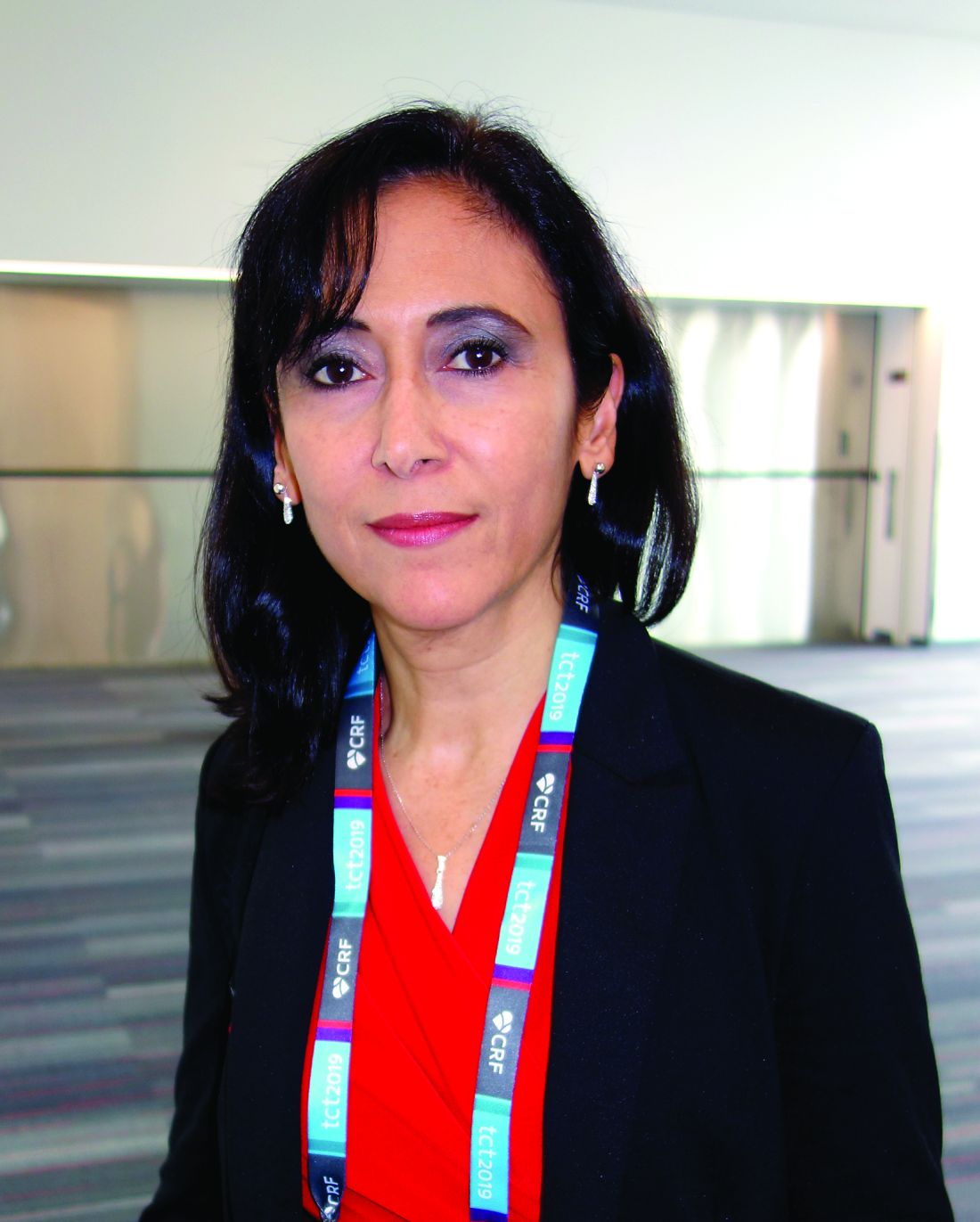User login
SAN FRANCISCO – and was an independent predictor of lower mortality at 1 year, in a review of 1,529 cases in the Society of Thoracic Surgeons transcatheter valve therapy registry.
Also, transcatheter mitral valve-in-valve (MViV) replacement, in general, is “preferable to redo mitral surgery and should be the standard of care for patients with failed surgical bioprosthesis who have favorable anatomy,” said lead investigator Mayra Guerrero, MD, an interventional cardiologist at the Mayo Clinic in Rochester, Minn, at the annual Transcatheter Cardiovascular Therapeutics meeting.
MViV replacement is a catheter-based alternative to a second open procedure for high-risk patients whose first surgically implanted mitral valve fails. The 30-day mortality tops 10% in most studies of redo operations, so the field’s been moving towards catheter treatment with the Edward Lifesciences Sapien 3 valve, which carries an indication for the procedure.
There’s been a lingering question, however, about whether it’s better to deliver the device through a hole in the atrial septum or the apex of the heart. The issue may now be resolved: “For the first time, we have found a statistical difference between the two access types” in favor of transseptal, Dr. Guerrero said at the meeting sponsored by the Cardiovascular Research Foundation.
The team compared outcomes from the 1,326 transseptal Sapien 3 cases in the registry with 203 cases that used the transapical approach from June 2015 and August 2019, linking cases with Centers of Medicare & Medicaid Services data to get a better idea of outcomes. Baseline characteristics were similar between the groups, but transapical cases tended to come earlier in the series because the field is also moving to the transseptal approach.
The procedures were technically successful – the primary safety endpoint – in 97.1% of transseptal and 94.6% of transapical patients. All-cause mortality at 1 year – the primary efficacy endpoint – was 15.8% transseptally and 21.7% transapically (hazard ratio, 0.67; 95% confidence interval, 0.47-0.97; P = .03).
Transapical cases were more likely to be converted to open surgery, and on multivariate analysis, transseptal access was an independent predictor of lower 1-year mortality.
There was good maintenance of valve performance and ejection fraction in both groups at 1 year, and similar improvements in heart failure symptoms and quality of life.
Transseptal 30-day mortality was 5% with an observed/expected ratio of 0.45 versus 8.1% transapical with an observed/expected ratio of 0.69.
“I don’t think any surgeon will disagree with this: If we don’t have to do another redo mitral valve operation, that’s a good thing. It’s one of the highest-risk procedures we do in cardiac surgery. To have an alternative that cuts that 30-day mortality down to 5% is very much positive. I think this clearly answers that this is the preferred therapy,” said cardiothoracic surgeon Michael Mack, MD, director of the cardiovascular service line at Baylor Scott & White Health System, Dallas.
The 1-year transseptal mortality of 16% is at least as good as transcatheter aortic valve replacement, but Dr. Mack and other panelists agreed that longer follow-up is needed to get a more complete picture of the procedure’s durability, especially as it begins to be used in patients who are at lower surgical risk.
For low-risk patients or patients that have, for instance, a small hypertrophic left ventricle and a surgical valve that already projects into the outflow tract, MViV replacement “could be very problematic, so there might need to be anatomic selection criteria we need to be thinking about,” said panelist Vinay Badhwar, MD, a cardiac surgeon at West Virginia University, Morgantown.
Subjects were aged an average of 73 years and 60% were women. The primary pathology was mitral stenosis followed by mitral regurgitation. The baseline mitral valve pressure gradient was about 13 mm Hg, which fell to 7 mm Hg in both groups at 1 year.
The work was funded by Edward Lifesciences, which did the statistical analysis. Dr. Guerrero disclosed research funding from the company.
SAN FRANCISCO – and was an independent predictor of lower mortality at 1 year, in a review of 1,529 cases in the Society of Thoracic Surgeons transcatheter valve therapy registry.
Also, transcatheter mitral valve-in-valve (MViV) replacement, in general, is “preferable to redo mitral surgery and should be the standard of care for patients with failed surgical bioprosthesis who have favorable anatomy,” said lead investigator Mayra Guerrero, MD, an interventional cardiologist at the Mayo Clinic in Rochester, Minn, at the annual Transcatheter Cardiovascular Therapeutics meeting.
MViV replacement is a catheter-based alternative to a second open procedure for high-risk patients whose first surgically implanted mitral valve fails. The 30-day mortality tops 10% in most studies of redo operations, so the field’s been moving towards catheter treatment with the Edward Lifesciences Sapien 3 valve, which carries an indication for the procedure.
There’s been a lingering question, however, about whether it’s better to deliver the device through a hole in the atrial septum or the apex of the heart. The issue may now be resolved: “For the first time, we have found a statistical difference between the two access types” in favor of transseptal, Dr. Guerrero said at the meeting sponsored by the Cardiovascular Research Foundation.
The team compared outcomes from the 1,326 transseptal Sapien 3 cases in the registry with 203 cases that used the transapical approach from June 2015 and August 2019, linking cases with Centers of Medicare & Medicaid Services data to get a better idea of outcomes. Baseline characteristics were similar between the groups, but transapical cases tended to come earlier in the series because the field is also moving to the transseptal approach.
The procedures were technically successful – the primary safety endpoint – in 97.1% of transseptal and 94.6% of transapical patients. All-cause mortality at 1 year – the primary efficacy endpoint – was 15.8% transseptally and 21.7% transapically (hazard ratio, 0.67; 95% confidence interval, 0.47-0.97; P = .03).
Transapical cases were more likely to be converted to open surgery, and on multivariate analysis, transseptal access was an independent predictor of lower 1-year mortality.
There was good maintenance of valve performance and ejection fraction in both groups at 1 year, and similar improvements in heart failure symptoms and quality of life.
Transseptal 30-day mortality was 5% with an observed/expected ratio of 0.45 versus 8.1% transapical with an observed/expected ratio of 0.69.
“I don’t think any surgeon will disagree with this: If we don’t have to do another redo mitral valve operation, that’s a good thing. It’s one of the highest-risk procedures we do in cardiac surgery. To have an alternative that cuts that 30-day mortality down to 5% is very much positive. I think this clearly answers that this is the preferred therapy,” said cardiothoracic surgeon Michael Mack, MD, director of the cardiovascular service line at Baylor Scott & White Health System, Dallas.
The 1-year transseptal mortality of 16% is at least as good as transcatheter aortic valve replacement, but Dr. Mack and other panelists agreed that longer follow-up is needed to get a more complete picture of the procedure’s durability, especially as it begins to be used in patients who are at lower surgical risk.
For low-risk patients or patients that have, for instance, a small hypertrophic left ventricle and a surgical valve that already projects into the outflow tract, MViV replacement “could be very problematic, so there might need to be anatomic selection criteria we need to be thinking about,” said panelist Vinay Badhwar, MD, a cardiac surgeon at West Virginia University, Morgantown.
Subjects were aged an average of 73 years and 60% were women. The primary pathology was mitral stenosis followed by mitral regurgitation. The baseline mitral valve pressure gradient was about 13 mm Hg, which fell to 7 mm Hg in both groups at 1 year.
The work was funded by Edward Lifesciences, which did the statistical analysis. Dr. Guerrero disclosed research funding from the company.
SAN FRANCISCO – and was an independent predictor of lower mortality at 1 year, in a review of 1,529 cases in the Society of Thoracic Surgeons transcatheter valve therapy registry.
Also, transcatheter mitral valve-in-valve (MViV) replacement, in general, is “preferable to redo mitral surgery and should be the standard of care for patients with failed surgical bioprosthesis who have favorable anatomy,” said lead investigator Mayra Guerrero, MD, an interventional cardiologist at the Mayo Clinic in Rochester, Minn, at the annual Transcatheter Cardiovascular Therapeutics meeting.
MViV replacement is a catheter-based alternative to a second open procedure for high-risk patients whose first surgically implanted mitral valve fails. The 30-day mortality tops 10% in most studies of redo operations, so the field’s been moving towards catheter treatment with the Edward Lifesciences Sapien 3 valve, which carries an indication for the procedure.
There’s been a lingering question, however, about whether it’s better to deliver the device through a hole in the atrial septum or the apex of the heart. The issue may now be resolved: “For the first time, we have found a statistical difference between the two access types” in favor of transseptal, Dr. Guerrero said at the meeting sponsored by the Cardiovascular Research Foundation.
The team compared outcomes from the 1,326 transseptal Sapien 3 cases in the registry with 203 cases that used the transapical approach from June 2015 and August 2019, linking cases with Centers of Medicare & Medicaid Services data to get a better idea of outcomes. Baseline characteristics were similar between the groups, but transapical cases tended to come earlier in the series because the field is also moving to the transseptal approach.
The procedures were technically successful – the primary safety endpoint – in 97.1% of transseptal and 94.6% of transapical patients. All-cause mortality at 1 year – the primary efficacy endpoint – was 15.8% transseptally and 21.7% transapically (hazard ratio, 0.67; 95% confidence interval, 0.47-0.97; P = .03).
Transapical cases were more likely to be converted to open surgery, and on multivariate analysis, transseptal access was an independent predictor of lower 1-year mortality.
There was good maintenance of valve performance and ejection fraction in both groups at 1 year, and similar improvements in heart failure symptoms and quality of life.
Transseptal 30-day mortality was 5% with an observed/expected ratio of 0.45 versus 8.1% transapical with an observed/expected ratio of 0.69.
“I don’t think any surgeon will disagree with this: If we don’t have to do another redo mitral valve operation, that’s a good thing. It’s one of the highest-risk procedures we do in cardiac surgery. To have an alternative that cuts that 30-day mortality down to 5% is very much positive. I think this clearly answers that this is the preferred therapy,” said cardiothoracic surgeon Michael Mack, MD, director of the cardiovascular service line at Baylor Scott & White Health System, Dallas.
The 1-year transseptal mortality of 16% is at least as good as transcatheter aortic valve replacement, but Dr. Mack and other panelists agreed that longer follow-up is needed to get a more complete picture of the procedure’s durability, especially as it begins to be used in patients who are at lower surgical risk.
For low-risk patients or patients that have, for instance, a small hypertrophic left ventricle and a surgical valve that already projects into the outflow tract, MViV replacement “could be very problematic, so there might need to be anatomic selection criteria we need to be thinking about,” said panelist Vinay Badhwar, MD, a cardiac surgeon at West Virginia University, Morgantown.
Subjects were aged an average of 73 years and 60% were women. The primary pathology was mitral stenosis followed by mitral regurgitation. The baseline mitral valve pressure gradient was about 13 mm Hg, which fell to 7 mm Hg in both groups at 1 year.
The work was funded by Edward Lifesciences, which did the statistical analysis. Dr. Guerrero disclosed research funding from the company.
REPORTING FROM TCT 2019


